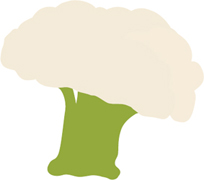
CAULIFLOWER
This three-in-one veg gives you an edible head of creamy florets and crunchy white stems encased by tender green leaves. Forget the substitute-for-potatoes-or-rice scenario and make the most of this affordable and versatile member of the cabbage family. Stir-fried, steamed, boiled or raw, cauliflower happily takes on bold flavours of sharp cheeses, biting mustards, spicy curries, Asian sauces and tangy pickles. It makes excellent soups from the simple and soothing to the sublime and delicate. Roasting cauliflower concentrates its sweetness, and puts it in a class of its own as side dish, salad or finger food with dips.
WHAT TO LOOK FOR
No plastic. Unwrapped is the way to go. Choose heads (or half heads) with tight, firm, creamy-white florets, and steer clear of any with black, slimy spots, which are signs of mould. Check the stems too and make sure there are no cracks or splits. Frozen florets will be fresher than those pre-packed plastic trays of florets that are often past their best-before date.
HOW TO STORE THEM
A head of cauli will keep in the fridge for a few days in a plastic bag.
WHAT’S IN THEM?
Half a cup of cooked cauliflower florets (about 90 g/3¼ oz) has around 90 kilojoules (22 calories), 2 g protein, no fat, 2 g carbs (2 g sugars, 0 g starches), 2 g fibre, 13 mg sodium and 284 mg potassium. Because cauliflower is so low in carbohydrate, it is not possible to measure its GI.
WHAT ELSE?
The milky head is the one we are most familiar with, but these days you’ll find orange, green (broccoflower) and purple caulis that hold their colour when cooked, making for a rather spectacular dish.
HERO RECIPES
Cauliflower and leek soup (here )
The original roasted whole cauliflower (here )